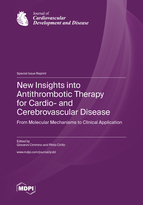New Insights into Antithrombotic Therapy for Cardio- and Cerebrovascular Disease: From Molecular Mechanisms to Clinical Application
A special issue of Journal of Cardiovascular Development and Disease (ISSN 2308-3425). This special issue belongs to the section "Stroke and Cerebrovascular Disease".
Deadline for manuscript submissions: closed (28 February 2023) | Viewed by 31211
Special Issue Editors
2. Vanvitelli Cardiology Unit, Monaldi Hospital, 80131 Naples, Italy
Interests: coagulation cascade; tissue factor; platelet pathophysiology; acute coronary syndrome; atherosclerosis; lipoprotein metabolism
Special Issues, Collections and Topics in MDPI journals
Interests: interventional cardiology; transcatheter aortic valve implantation; percutaneous coronary intervention; coronary artery; aortic stenosis
Special Issues, Collections and Topics in MDPI journals
Special Issue Information
Dear Colleagues,
Atherosclerotic disease and its thrombotic complication are the pathophysiological substrate underlying several clinical conditions, such as acute and chronic coronary syndrome (ACS and CCS, respectively), stroke, and peripheral artery disease. Activation of coagulation cascade as well as platelet aggregation are key steps of the thrombotic process. Vessel injury results in exposure of the glycoprotein tissue factor (TF) to flowing blood. Once exposed, TF binds factor VII/VIIa (FVII/FVIIa), and in the presence of calcium ions, it forms a tertiary complex able to activate FX to FXa, FIX to FIXa, and FVIIa itself. The final step is thrombin formation at the site of vessel injury with subsequent platelet activation, fibrinogen to fibrin conversion, and ultimately thrombus formation. Platelets are crucial cells in primary hemostasis. For years, they have been considered only as cell fragments participating in primary hemostasis. However, recent advances in platelets pathophysiology have shown that these cells are able to regulate their gene and protein expression, make de novo protein synthesis, and release different mediators with paracrine effects that may interfere with different cell function. Pharmacological modulation of both components of thrombosis, the coagulation cascade and platelet activation, is of great clinical importance. Several clinical trials have clearly shown the efficacy of anticoagulation and/or anti platelet aggregation in different thrombotic disorders. However, real-world practice clearly indicated that antithrombotic strategies need to be personalized according to patient characteristics, such as age, concomitant diseases already requiring antithrombotic drugs or at risk for bleeding. In this regard, the combination of multiple antithrombotic drugs represents a challenging scenario and was therefore the focus for multiple recent randomized controlled trials, with more still to come. As knowledge about platelets and the coagulation system has substantially evolved within the last few years, so should our approach to antithrombotic treatment. Finally, the ongoing global pandemic of coronavirus disease 2019 (COVID‑19) has also modified our antithrombotic strategies for acute ischemic events.
This issue will focus on current hurdles of antithrombotic treatments in patients with cardio- and cerebrovascular diseases, starting from the molecular mechanisms involved, proposing practical solutions to compelling clinical scenarios using a pathophysiology-oriented approach on the basis of current clinical evidence.
Prof. Dr. Giovanni Cimmino
Prof. Dr. Plinio Cirillo
Guest Editors
Manuscript Submission Information
Manuscripts should be submitted online at www.mdpi.com by registering and logging in to this website. Once you are registered, click here to go to the submission form. Manuscripts can be submitted until the deadline. All submissions that pass pre-check are peer-reviewed. Accepted papers will be published continuously in the journal (as soon as accepted) and will be listed together on the special issue website. Research articles, review articles as well as short communications are invited. For planned papers, a title and short abstract (about 100 words) can be sent to the Editorial Office for announcement on this website.
Submitted manuscripts should not have been published previously, nor be under consideration for publication elsewhere (except conference proceedings papers). All manuscripts are thoroughly refereed through a single-blind peer-review process. A guide for authors and other relevant information for submission of manuscripts is available on the Instructions for Authors page. Journal of Cardiovascular Development and Disease is an international peer-reviewed open access monthly journal published by MDPI.
Please visit the Instructions for Authors page before submitting a manuscript. The Article Processing Charge (APC) for publication in this open access journal is 2700 CHF (Swiss Francs). Submitted papers should be well formatted and use good English. Authors may use MDPI's English editing service prior to publication or during author revisions.
Keywords
- tissue factor
- coagulation cascade
- platelets
- aggregation
- thrombosis
- acute coronary syndrome
- stroke
- peripheral artery disease
- COVID-19 pandemic








